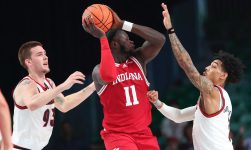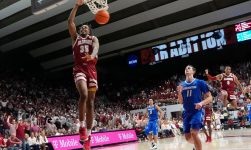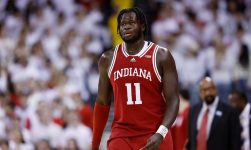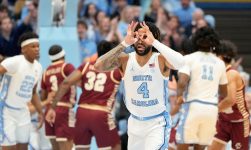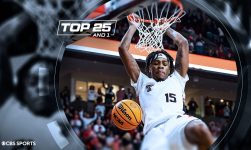In what has been the longest offseason in the history of modern college hoops, I decided to take on ambitious personal project: seeking to objectively rank the most accomplished and successful programs in men’s college basketball.
And so I did, and so here we are. Over the next three days CBS Sports will be revealing the best programs in the sport’s history — or history as college basketball is destined to frame itself. I did not go back to the very beginning (the late 1800s) when conferences, shot clocks, Adolph Rupp, the 3-point line, Bing Crosby, the NCAA Tournament, John Wooden and dunks did not exist.
The NCAA Tournament is the gauge for greatness and relevancy. It’s been that way for decades and will remain that way forevermore. So for our purposes here “college basketball history” begins with the dawn of the NCAA Tournament, the 1938-39 season. That starting point ensures every team that existed as far back as 1938 has a shot at inclusion — and you’ll learn about the programs to arrive afterward that still managed to win enough to make their way into the rankings. We’re going with 68 because NCAA Tournament themes etc., etc.
The rankings were compiled using an objective statistical formula based on 13 categories: wins, losses, national championships, Final Four appearances, Elite Eight appearances, NCAA Tournament bids, regular-season championships, NIT championships (they held significant value long ago), total weeks ranked, wins over ranked opponents, top-10 NBA Draft picks, first-round/11-30 NBA draft picks and second round/31-60 NBA draft picks.
Each team had their categories added up and that led to a point total. All appearances in the NCAA Tournament, Final Four, all vacated wins did count in this scenario. The teams played those games, and won or lost them. They happened, so they count. More than 100 schools were considered for the list. Every team that’s made a national championship game, or reached at least two Final Fours, or played in at least eight NCAA Tournaments and/or currently resides in one of college basketball’s seven major conferences (AAC, ACC, Big East, Big Ten, Big 12, SEC, Pac-12) was tabulated. Teams did not get double credit for NCAA Tournament success, meaning if a team made two Final Fours but one of them was a national championship and the other was a loss in the national semifinals, they were credit individually for the title, then separately credited for a Final Four. I will reveal the point values for each criterion when we post the top 25 on Thursday.
I relied on data from the NCAA record book, Sports Reference, RealGM.com, CollegePollArchive.com, Stats Inc., school record books, KenPom.com and ESPN’s College Basketball Encyclopedia. CBS Sports ace researcher Andy Tulin was absolutely vital in researching each team’s all time win total vs. ranked opponents. Andy, thank you again.
Now let’s get to the ultimate list of the greatest men’s basketball programs in the NCAA Tournament era.
68. Pitt
Record since 1938-39: 1,256-982 | Regular-season titles: 6
NCAA Tournaments: 26 | Final Fours: 1
Weeks ranked: 258 | Top-60 NBA picks: 20
POINTS: 358.3
We kick things off with the Panthers. Remember, this ranking’s criteria begins with the first season of the NCAA Tournament era (1938-39), so Pitt’s national championships from 1928 and 1930 do not apply. Fun fact: Pitt’s 57-37 win over Fordham in 1940 was the first televised college basketball game in history. Pitt fans can thank Jamie Dixon for juuuust climbing onto this list. Dixon coached Pitt from 2003-16 and made the NCAAs all but two seasons, taking Pitt to the Elite Eight twice and winning 73% of his games (328-123). He altered the perception of the program, winning big when the Big East was a crowded, tough league throughout the aughts. The Panthers have 111 wins over ranked teams in their history. Only one Final Four, back in 1941, and two more Elite Eight showings in 1974 and 2009. If Dixon’s the most important coach in school history, Doc Carlson’s not far behind — he won more games than any other (367) and coached Pitt from 1922-50. Best player in school history? Probably Charles Smith, who won Big East Player of the Year in 1988 — the same year the most famous play in school history (“Send it in, Jerome!”) happened.
Record since 1938-39: 1,218-908 | Regular-season titles: 2
NCAA Tournaments: 22 | Final Fours: 2
Weeks ranked: 156 | Top-60 NBA picks: 31
POINTS: 362.6
I’ll admit to being pretty curious from the outset about whether DePaul was going to have enough to make it. Just barely. Give it two more years, and I’m thinking the Blue Demons are somewhere in the 70s. But 22 NCAA Tournaments and 31 draft picks (higher number than I realized) gets it done. Domination in the 1940s and big play in the late ’70s/early ’80s help DePaul’s case. The 1944-45 team won an NIT title (back when an NIT title meant more than an NCAA title) with George Mikan in the middle. Mikan, Mark Aguirre and Terry Cummings are the only consensus All-Americans in program history — and they were all coached by the late, great Ray Meyer, who was in charge of the program from 1942-84. That seems like a lifetime but is in fact only one year longer than Mike Krzyzewski has been coaching Duke. The fact DePaul can still make a list like this despite having made one NCAA Tournament in the past 20 seasons (and none since 2004) speaks to the proud history there. So overdue for a resurgence.
Jason Kidd had a stellar two-season career at Cal before leaving for the NBA in 1994.
Getty Images
66. Cal
Record since 1938-39: 1,257-1,021 | Regular-season titles: 7
NCAA Tournaments: 19 | Final Fours: 2
Weeks ranked: 97 | Top-60 NBA picks: 31
POINTS: 363.2
A bit bland as a basketball brand, but realize that California has a national title to it name (1959) and has occasionally popped here and there. It won an NIT title in 1999 as well. Along the way Cal’s had 31 NBA picks in the top 60 since the 1940s. The Golden Bears have five Consensus All-Americans in their history, the most recent being Jason Kidd in 1994 (who was Freshman of the Year nationally a season prior). Three of the others came before 1939, while center Darrall Imhoff was the key piece on the title-winning ’59 team and the Final Four-bound 1960 squad. It was Imhoff’s put-back that won the 1959 championship in the closing seconds over Jerry West and West Virginia. Those great Cal clubs were led by Hall of Fame coach Pete Newell, who holds the distinction of being the best coach in program history with the shortest tenure: he was only at Cal from 1954-60! Winningest coach in history is Ben Braun (219-154). As for Kidd, he provided a program peak in 1993 when he had 14 assists, and Lamond Murray had 28 points, to lift sixth-seeded Cal over No. 3 Duke, ending the Blue Devils’ reign after winning the two previous NCAA Tournaments. Strange but true: Cal has still never won a conference tournament championship.
Record since 1938-39: 1,315-926 | Regular-season titles: 3
NCAA Tournaments: 15 | Final Fours: 0
Weeks ranked: 204 | Top-60 NBA picks: 24
POINTS: 365.4
Vandy’s been just good enough just often enough to get past security here. It also didn’t have a losing season from 1948-49 until 1969-70. Only one Consensus All-American (Clyde Lee in 1966) in program history. Kevin Stallings’ 332 wins from 1999-2016 makes him the most successful coach in school history, though things ended with a thud there. Nevertheless Stallings took Vandy to seven NCAA tourneys and made a pair of Sweet 16s. The ‘Dores almost made the 1965 Final Four, but that remains their only Elite Eight showing. Vanderbilt has 103 wins over ranked opponents in the past 60-plus years, which was crucial to getting it onto the list. It’s not an every-other-year thing for Vandy to have a great player on a national level, but guys like Jeff Turner, Will Perdue, Shan Foster, John Jenkins and Jeffrey Taylor are program legends in their own right. And shouts to Festus Ezeli while we’re at it.
64. New Mexico State
Record since 1938-39: 1,251-869 | Regular-season titles: 17
NCAA Tournaments: 25 | Final Fours: 1
Weeks ranked: 64 | Top-60 NBA picks: 9
POINTS: 370.9
The Aggies have been running roughshod through the WAC for 13 years, that streak of domination (10 titles) easily flinging NMSU into these rankings. The coaches responsible for NCAA Tournament appearances in that span: Reggie Theus, Marvin Menzies, Paul Weir and, as of late, Chris Jans. Best coach in program history is the great Lou Henson, who also thrived at Illinois but finished with 307 wins after his final season in coaching in 2004-05. Henson died at the age of 88 in July. This is a proud program tucked out in Las Cruces, New Mexico, its banner-defining season coming in 1970 when the Aggies made a run to the Final Four before being taken out by Sidney Wicks and UCLA. Best player in program history is a man by the name of Sam Lacey, a center from 1967-70 and someone who put up 17.7 points and 15.9 boards in 1969-70 to make First Team All-America. He went on to be the No. 5 pick in the NBA Draft. The best NBA player to come out of NMSU is obvious: Pascal Siakam, who quietly dominated (16.6 ppg, 9.7 rpg, 2.0 bpg from 2014-16) in two seasons (2015-16). Perhaps the sweetest thing for Aggie fans: their team made the list, but New Mexico (spoiler alert) did not.
Record since 1938-39: 1,372-912 | Regular-season titles: 12
NCAA Tournaments: 21 | Final Fours: 0
Weeks ranked: 48 | Top-60 NBA picks: 10
POINTS: 372.3
Back-to-back Aggie schools. Yes, you’re going to see a half-dozen-or-so programs make this list that will surprise you. Perhaps Utah State is one of those programs. After all: zero Final Fours, only 48 weeks ranked, a mere 10 NBA picks and not one First Team All-American. So what gives? Well, 1,372 wins is what gives. That’s the 34th most in college basketball since 1938-39. That’s how you crack through. Keep in mind this list is objective and statistical and will reward programs in smaller leagues who were really good for decades-long stretches. USU has been one of the final eight teams remaining twice: 1939 and 1970. It also squeaked in a Sweet 16 showing in 1964. There’s something special in Logan, and the I-believe-that-we-will-win ethos that’s permeated since the latter years of the Stew Morrill era have kept this team highly successful for much of the past two decades. Utah State is 480-207 the past 20 seasons, and during Morrill’s 17-year run with the Aggies, the program had the fourth-best winning percentage in men’s D-I, trailing only Gonzaga, Duke and Kansas. In the here and now, Utah State just graduated one of its greatest players ever, Sam Merrill, and junior center Neemias Queta could prove to be even more valuable by the time his time is up in Logan. Craig Smith has it rolling there.
Texas Western, coached by the legendary Don Haskins, made history by winning the 1966 NCAA Tournament.
Getty Images
Record since 1938-39: 1,333-915 | Regular-season titles: 11
NCAA Tournaments: 17 | Final Fours: 1
Weeks ranked: 60 | Top-60 NBA picks: 17
POINTS: 373
UTEP was known as Texas Western in 1966, when one of the greatest stories in college basketball history was written. The Miners beating Kentucky in the national championship game with a starting five of all Black players was so important, it affected desegregation in college sports into the late 1960s and eventually was made into a movie (2006’s “Glory Road“). I’ll reveal my points system in the final piece of this series, but know this: winning that title in ’66 vaulted UTEP into the rankings. It doesn’t make it without it. It deserves to be here, though. Don Haskins guided UTEP from 1961 until 1999, winning 719 games (to just 353 losses) and building a Hall of Fame resume along the way. UTEP has bounced around leagues over the years, going from the Border Conference to the WAC to Conference USA in 2005. It’s not the reliable 20-win machine it once was (three NCAA Tournament bids since 1992). You might not have realized: UTEP’s top two alums in hoops are Tiny Archibald and Tim Hardaway. Kinda cool about how this list landed: UTEP and New Mexico State are pretty isolated on the D-I hoops map, but the schools are 50 miles apart and so they always play a two-fer each year out of scheduling convenience. Almost kismet how they wind up separate by just two spots here.
Record since 1938-39: 1,051-629 | Regular-season titles: 22
NCAA Tournaments: 16 | Final Fours: 0
Weeks ranked: 7 | Top-60 NBA picks: 7
POINTS: 373.2
Fewest AP Top 25 appearances of any school to make it, but the wins and outstanding win percentage get the Wildcats onto the list. Maybe this is the most surprising inclusion of all. Damian Lillard’s alma mater can thank its runs through the Big Sky. Weber State’s 22 league championships are the 20th-most in D-I dating back to 1963-64, its first year in a league. WSU, located in Ogden, Utah, didn’t even have a program until 1962. This is truly impressive and goes to show you that you can be prestigious and not need to be in a power conference. The Wildcats made the Sweet 16 in 1969 and 1972. Lillard is of course the best player in school history, but he never made the NCAA Tournament. Harold “the Show” Arceneaux did, though, and everyone over the age of 35 remembers what No. 14 Weber State did to mighty No. 3 North Carolina in 1999: 76-74 thanks to 36 from Arceneaux and a program-record 14 3-pointers. It remains the only time UNC has lost in the first round in the 64/68-team era.
Record since 1938-39: 1,330-977 | Regular-season titles: 11
NCAA Tournaments: 15 | Final Fours: 2
Weeks ranked: 161 | Top-60 NBA picks: 15
POINTS: 374.6
In the past 10 years, Gregg Marshall elevated Wichita State to a top-40 program nationally. Coincidentally, this list publishes on the same day Marshall has resigned from the school. In the big picture, Shockers fans can now boast about having one of the 60 best programs, historically, in the sport. Marshall didn’t build it alone; Wichita State was relevant in two periods before. The 1963-64 team, led by Dave Stallworth, was ranked top-five in the nation and made the Elite Eight after beating nine ranked opponents that season. A year later WSU was in the Final Four. In the early 1980s, Xavier McDaniel was a revelation for the Shockers at the time because he was the first player in men’s D-I history to lead the nation in scoring and rebound average. McDaniel and Stallworth were Consensus All-Americans — a bar Fred VanVleet, Ron Baker, Cleanthony Early and Landry Shamet failed to meet. A pair of Final Fours, four Elite Eights, six Sweet 16s. Ralph Miller, Gary Thompson, Gene Smithson and Mark Turgeon all laid the foundation — then Marshall brought the program to its most prominence and dominance ever. The 2013 Final Four was an unexpected run as a No. 9 seed, but it was the following year’s undefeated regular season run, punctuated by the No. 1 seed, that was the example set that you could be from a small league (remember, the Shockers were in the Missouri Valley then), beat good opponents and be rewarded with a top seed. If not for one of the greatest games in NCAA Tournament history — under-seeded Kentucky beating Wichita State in the second round — that Shockers team’s legacy would shine even brighter.
Record since 1938-39: 1,131-890 | Regular-season titles: 3
NCAA Tournaments: 14 | Final Fours: 1
Weeks ranked: 231 | Top-60 NBA picks: 32
POINTS: 380.1
The only Final Four in school history is vacated. But I am not removing the vacated wins. Minnesota’s academic fraud scandal ripped out every victory from 1993-94 through 1997-98 in the NCAA books. Not here: Minnesota keeps those 115 Ws. To hell with the Man, who’s with me! The Gophers have been the only Division I team in their state forever (that changes in the coming years with St. Thomas) but they’ve never been consistently relevant in the Big Ten, which they’ve been a member of dating back to 1905. Three NIT titles, though. And a couple of NBA legends as alumni: Kevin McHale and Mychal Thompson. Thompson was a Consensus All-American in 1978, while Dick Garmaker (1955) and Jim McIntyre (1948) also earned the honor. The best coach in school history is … Doc Cooke? He stopped coaching in 1924. Yeah: 1924. Fascinating program, this one. Those 231 weeks ranked in the polls came in handy, I tell ya. This school also lands in the top five of my gotta-go-there venues. Never been to The Barn and would love to see a game in those confines once this whole pandemic thing passes us by.
Record since 1938-39: 1,247-947 | Regular-season titles: 4
NCAA Tournaments: 18 | Final Fours: 2
Weeks ranked: 179 | Top-60 NBA picks: 38
POINTS: 383.4
Undeniably eclipsed for decades by UCLA — and that’s why USC has only four regular-season titles — Southern Cal has still been good enough and loaded with enough talent to validate being a top-60 program. There was even a time, in the early 1970s, when USC was ranked No. 1 and UCLA No. 2. This program can claim three Consensus All-Americans since 1939: Ralph Vaughn (1940), Bill Sharman (1950) and Harold Miner (1992). The Final Fours came in 1940 and 1954; the only other Elite Eight showing was in 2001, when Henry Bibby was coach and Brian Scalabrine the star. USC’s 38 top-60 NBA picks ranks as the 16th most of any program in college basketball history — and a reminder of why I included producing NBA talent as a criterion. It’s not the most significant, but if a hallmark of your program is an ability to get players drafted, that is significant and reflects your standing in the sport. Historically, USC has been a reliable place to advance your career if you’re a high-end hoops talent. That will bear out yet again this season, when Trojans freshman center Evan Mobley inevitably goes on to be a top-five draft pick in 2021.
Record since 1938-39: 1,377-966 | Regular-season titles: 7
NCAA Tournaments: 9 | Final Fours: 2
Weeks ranked: 128 | Top-60 NBA picks: 25
POINTS: 384.8
Yeah, another surprising small-conference team, but look at the win total, look at the weeks ranked and keep in mind two Final Fours. You don’t automatically qualify for this list because you are in a major conference. Here’s a program that is totally overlooked for its history. Bradley was one of 10-20 best programs in college hoops for an entire decade — the 1950s — and as I’ll remind you a few times in this series, what a team did in 1939 or 1954 means just as much as what a team did in 2006 or 2019. Bradley’s power years are what gets it onto the list. This team had a dude named “Squeaky” Melchiorre carry it to the Final Four … but unfortunately Squeaky and some of his teammates took bribes to shave points during the 1951 NCAA Tournament. Not good! Chuck Orsborn’s .776 win percentage (194-56) included two NIT titles and five more NIT showings in the 1950s and 1960s at a time when that tournament was considered as legitimate as the NCAA Tournament. We also must give a nod to Hersey Hawkins, the most exciting player in school history. Hawkins is one of fewer than 25 players in history to finish with more than 3,000 points (3,008).
Wake Forest’s Tim Duncan capped off his career by winning national player of the year honors in 1997.
Getty Images
Record since 1938-39: 1,266-1,031 | Regular-season titles: 4
NCAA Tournaments: 23 | Final Fours: 1
Weeks ranked: 275 | Top-60 NBA picks: 25
POINTS: 386.5
Like many teams on this list, Wake Forest was hampered by one season; it didn’t play in 1943-44 because of World War II. (That said, Bradley didn’t play for two seasons because of WWII.) Something that will help you shape perspective on this list and the criteria taken into account: Wake Forest has been ranked for 275 weeks in school history. The 2020 preseason AP Top 25 broke the tie with the Demon Deacons and … Gonzaga, which now sits at 276. Only thing is, Wake Forest had about a five-decade start on the Zags. If you look at the history of the program, it’s been prone to decades-long droughts and suffered from being the fourth-best North Carolina-based ACC school. Still, playing in the ACC has benefited Wake Forest to the tune of getting 25 players drafted and winning 149 games vs. ranked opponents, which averages out to approximately 2.5 wins per season over Top 25 teams. Wake fans can thank Dave Odom and Tim Duncan, for it was the Odom era, with the peak 1992-97, that vaulted the Deacs to top-20 status in the sport for much of that span. In addition to Duncan, Len Chappell (1962), Josh Howard (2003) and Chris Paul (2005) were Consensus All-Americans. And who knows what Wake would have become had Skip Prosser not died tragically and unexpectedly in 2007; Prosser was 126-68 in six seasons.
Record since 1938-39: 1,191-993 | Regular-season titles: 7
NCAA Tournaments: 24 | Final Fours: 4
Weeks ranked: 266 | Top-60 NBA picks: 17
POINTS: 391.6
There are a couple of schools that were hurt by my decision to not go all the way back to 1900 when taking into consideration the data for this list. Wisconsin is certainly one of them. Doc Meanwell and Harold Foster guided UW to what would seem to be top-10 status in the sport pre- and post World War I. Foster was still around in 1941, when UW won the national title, and he didn’t retire until 1959, so his success is reflected on this list. But if you’re surprised to see Wisconsin at 55th instead of near the top 40 or inside the top 30, you’re likely under the age of 30. Because UW was downright dreadful for nearly 50 years, from about 1950 up until the turn of the century. It went from no NCAA Tournament for four-plus decades to being in it almost every year since 1997. Dick Bennett and Bo Ryan changed UW’s perception for good, so much so that a hallmark of the Ryan era was one of the most repeated facts about his team: it almost always finished in the top four of the Big Ten standings, regardless of preseason hype of (a lack of) four- and five-star talent. The recent peak was making back-to-back Final Fours in 2014 and ’15, the latter of which included Frank Kaminsky, Sam Dekker and company ending Kentucky’s bid for an undefeated season. Kaminsky joined Gene Euglund (1941), John Kotz (1942) and Alando Tucker (2007) as the only Consensus All-Americans at Wisconsin since 1939. Amazingly, it had 14 players win the award between 1905-18.
Record since 1938-39: 1,147-768 | Regular-season titles: 0
NCAA Tournaments: 20 | Final Fours: 2
Weeks ranked: 143 | Top-60 NBA picks: 28
POINTS: 394.8
On the top five list of most surprising things I learned doing this list: Providence hangs zero regular-season conference championship banners for men’s basketball. But it makes the list regardless! Ed Cooley is responsible for 25% of PC’s NCAA Tournament showings — and he’s coached at the school since 2011. PC’s been playing ball since 1917, don’t you know? The Friars have had big moments, for certain: Dave Gavitt coaching up Ernie DiGregorio and Marvin Barnes en route to the 1973 Final Four; Rick Pitino taking them back to the national semis with Billy Donovan in 1987; Jim Calhoun almost losing his mind for not recruiting Ryan Gomes; Cooley using a towel to cover his rear after his pants ripped in the 2018 Big East Tournament.
Gomes, DiGregorio, Barnes and Jimmy Walker are the four Consensus A-As in school history, but I’d be remiss to not mention Lenny Wilkens was the No. 6 overall pick out of Providence in 1960. You don’t get the story of the Big East without Gavitt, so Providence holds a special place in college basketball lore, even if it’s never consistently been a top-40 program in the sport. It’s done enough over the years to prove it’s borderline top 50. The Friars hold a fiery rivalry with URI, so PC fans, consider this your trump card from here on out.
Record since 1938-39: 1,254-964 | Regular-season titles: 7
NCAA Tournaments: 17 | Final Fours: 2
Weeks ranked: 200 | Top-60 NBA picks: 31
POINTS: 397
Safe to say Mike Montgomery is almost solely responsible for getting Stanford to this party. The Cardinal did not play in ONE NCAA Tournament between 1942 and 1989. Astounding — and yet! And yet, here is Stanford. The two Final Fours came in 1942 and 1998. Montgomery coached in the Cardinal from 1986-2004, winning a school-record 393 games and making the Big Dance 12 times. Montgomery has a higher percentage of NCAA Tournament appearances for his school in its history than any other coach for any other school on this list with at least 15 overall NCAA Tournament appearances. That ’97-98 Cardinal crew is the peak of the program, playing in the Final Four against Kentucky but losing 86-85 in overtime. Mark Madsen, Arthur Lee and Tim Young proving that one of the most prestigious academic institutions in America could compete at the top of college basketball. Three years later, Casey Jacobsen would become the first — and to this point only — Consensus All-American to play at Stanford since 1938-39. For me, there is one highlight that lives forever in glory. It’s 2003. Stanford is undefeated. Maples Pavilion has, over the course of nearly a decade, become one of the 15-or-so most intimidating road environments in the country. The Cardinal are playing against Arizona in the most anticipated matchup of the weekend — an early afternoon tip out West. The game is headed to overtime, until Nick Robinson hits a running 35-footer to win it at the horn. “Yes! Yes! Yes! Yes!” Brent Musburger, you’re glorious.
Record since 1938-39: 1,275-1,023 | Regular-season titles: 10
NCAA Tournaments: 22 | Final Fours: 4
Weeks ranked: 215 | Top-60 NBA picks: 38
POINTS: 419
Bob Pettit, Pete Maravich, Chris Jackson, Shaquille O’Neal, Ben Simmons. All either won Freshman of the Year, Player of the Year, was a Consensus First Team All-American or made the Hall of Fame. LSU has a proud hoops history, and it’s been able to build that up despite always playing a distant second, third or fourth fiddle in the SEC. Maravich will probably forever be the NCAA’s all-time scoring leader (3,667 points), made all the more absurd by the fact he played when there was no 3-point line. The man averaged 44.2 points (!!), which is never getting broken at the D-I level. Never. Dale Brown, who coached Jackson and O’Neal, is the second best SEC basketball coach in history to Adolph Rupp. Current controversies with the program aside, LSU has long been viewed as a top-five SEC hoops job, though it exists under the humongous shadow of Tigers football. But on the court, this has been a program with pop, making the Elite Eight six times (1953, 1980, 1981, 1986, 1987, 2006) and cracking through to the national semis four of those times. LSU’s also had eight top-five picks, which ranks in the top 10 in the sport. The element that keeps LSU outside the top 50 is that for all of the razzle-dazzle of evolutionary play Maravich brought to basketball, he never made the NCAA Tournament.
Record since 1938-39: 1,327-1,003 | Regular-season titles: 11
NCAA Tournaments: 17 | Final Fours: 1
Weeks ranked: 162 | Top-60 NBA picks: 36
POINTS: 421.7
That Final Four appearance turned 67 this year. Washington should be 10-15 spots higher, given how much talent has come out of the greater Seattle area in the past 25 years, but alas. The school has retired only three numbers: Isaiah Thomas’ No. 2, Brandon Roy’s No. 3 and Bob Houbregs’ No. 25. Roy and Houbregs were Consensus All-Americans. Washington was damn good in the early part of the 20th century, but Hec Edmundson coached his final game in 1947. He finished with a 488-195 record and still remains, by far, the best coach in Huskies history. After that, the program largely was hit-or-miss. It didn’t make one NCAA Tournament from 1954-76. There was a climb back toward relevancy in the 1980s, thanks to Chris Welp, who with 2,073 points is the school’s all-time leading scorer. Washington’s been able to bring in draftable talent more regularly, but it hasn’t converted to sustained success. According to KenPom.com, which tracks data back to 1996-97, Washington rated as the best Pac-10/Pac-12 team only twice, in 2009 and 2011. UW did make the 2019s NCAAs, ending an eight-year drought. With Mike Hopkins in charge, the hope is Washington can push back to being a top-five team in the conference on an annual basis.
Coming Wednesday: teams Nos. 50-26.

